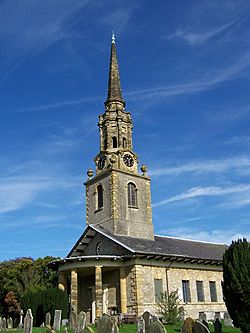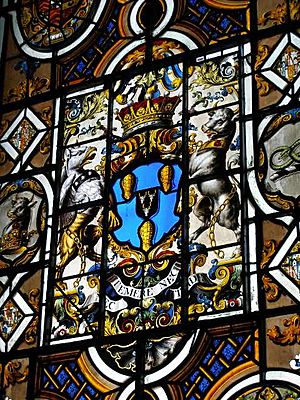St Lawrence's Church, Mereworth facts for kids
Quick facts for kids St Lawrence's Church, Mereworth |
|
|---|---|

St Lawrence's, October 2006
|
|
| 51°15′32″N 0°22′40″E / 51.25875°N 0.37790°E | |
| OS grid reference | TQ 660 537 |
| Location | Mereworth, Kent |
| Country | England |
| Denomination | Church of England |
| History | |
| Status | Parish church |
| Founder(s) | John Fane, 7th Earl of Westmorland |
| Consecrated | 26 August 1746 |
| Architecture | |
| Functional status | Active |
| Heritage designation | Grade I listed |
| Style | Neo-Palladian |
| Groundbreaking | 1744 |
| Completed | 1746 |
| Specifications | |
| Number of spires | One |
| Administration | |
| Parish | Mereworth |
| Deanery | West Malling |
| Diocese | Rochester |
| Province | Canterbury |
St Lawrence's Church is an Anglican church located in Mereworth, Kent, England. It was built in the mid-1740s by John Fane, the 7th Earl of Westmorland. He moved the old 12th-century church to make room for a bigger Mereworth Castle.
This church is built in a special style called Neo-Palladian. It is known as a very important 18th-century church in Kent. We don't know for sure who designed it. Some famous architects like Henry Flitcroft, James Gibbs, and Roger Morris might have been involved.
Inside, you can still see many old parts from the medieval church. These include stained glass with family symbols and beautiful stone memorials. The church has been repaired several times over the years. This includes fixing damage from World War II bombs. It also had a big restoration in 2009. St Lawrence's Church is a Grade I listed building. This means it is very important for its history and architecture.
Contents
History of St Lawrence's Church
The First Church in Mereworth
There was a church dedicated to St Lawrence in Mereworth a very long time ago. It existed during the time of King Henry II (1154–89). The right to choose the priest for this church belonged to Roger de Mereworth.
The first church was built by the de Clare family. Later, it was given to the Knights Hospitallers. There was a disagreement about who owned the church between Roger de Mereworth and Leeds Priory. The Bishop of Rochester, Gilbert, helped settle this argument. He decided that de Mereworth owned it. However, the church's priest had to pay money to the priory every year.
After this, the church was given to Tonbridge Priory. It stayed with them until 1525 when the priory was closed down. Then, the church became the property of Cardinal Wolsey. But it was taken by the King in 1529.
The right to choose the priest then went to Sir George Nevill. It passed through his family until it came to Mary and her husband Thomas Fane. In 1589, Leeds Priory gave up their claim to the yearly payment. By 1634, the church owned a lot of land in Mereworth.
In the 1720s, Mereworth Castle was rebuilt in a new style. In the 1740s, more buildings were added to the castle. This meant the old church had to be moved. In 1744, John Fane, the 7th Earl of Westmorland, got permission to pull down the "ancient and most inconvenient" church.
Building the Current Church
John Fane built the new church in the middle of the village. It was about 1 kilometer (5/8 mile) northwest of the old one. Building started in 1744 and finished two years later. The church was officially opened by Joseph Wilcocks, the Bishop of Rochester, on August 26, 1746.
Old coffins and memorials from the first church were moved to the new building. The first person to be baptised in the new church was John Grinsted's son on September 23, 1746. There had been no baptisms or weddings in the village in 1745 because there was no church.
In 1752, Horace Walpole visited the church. He thought the spire was so tall it made the church look small. Thomas Benge Burr wrote in 1766 that the church was worth a careful look by any curious traveler.
The church was "repaired and beautified" in 1770. This work might have been done by Nicholas Revett. In 1798, Francis, Lord de Despencer owned the right to choose the priest.
The spire was rebuilt in 1870. In 1875, a new round window was added to the east wall. The bells were fixed in 1885. A clock was put in the tower in 1894 to remember Eliot Stapleton, who was the rector (priest) from 1874 to 1892. A plan to make the church bigger in 1896 was not carried out.
Major repairs were done to the spire in 1946–47. This was because of damage from World War II. In 1957, the bells were repaired again. On August 25, 1959, the church became a listed building. It is a Grade I listed building, which is the highest level. The clock was repaired in 1972 to remember George Prentice, who was rector from 1966 to 1970. A new clock face was put in, and the winding system became electric.
In 2005, an inspection showed the church needed big repairs. English Heritage gave a grant to cover most of the £500,000 cost. The work was finished in 2009. It won an award for the best restoration of a Georgian church.
The church is still used for worship today. You can find more details on its website.
Church Design and Features
Outside the Church
St Lawrence's is a Palladian-style building. We don't know who the architect was. Some think it might have been designed by followers of Colen Campbell. Others suggest Henry Flitcroft or James Gibbs. Sir Howard Colvin thinks it might have been Roger Morris.
The church is made of Kentish ragstone blocks. It has smooth sandstone for the porch columns and corners. The roof is covered in slate. It has a simple rectangular shape, like an 18th-century "temple church." The design was inspired by St Paul's, Covent Garden in London.
A tall tower with a steeple rises above the roof at the west end. It has decorative urns. This stone tower looks very much like the steeple at St Giles in the Fields. A round porch with columns sticks out from the west end. Its design is similar to St Paul's, Deptford. The tower has six bells, made in 1746.
Inside the Church

The inside of the church has a Neoclassical style. You enter through a porch at the west end. This leads into a round room at the base of the tower. Rooms on the sides of this entrance hold memorials from the old church.
On the north side is the Yotes Court Chapel. Here you can find a brass memorial of William Shosmyth and his wife. William Shosmyth was a leader of a religious group in 1461. This brass has the oldest known picture of their group's coat of arms. Today, this chapel is used as a vestry (a room for the priest).
On the south side is the Despencer or Lady Chapel. It has brass memorials for Sir John de Mereworth and Thomas Nevill. There are also monuments to Edward Neville, 3rd Baron Bergavenny or his son George Nevill, 4th Baron Bergavenny. Another memorial holds the heart of George Nevill, 5th Baron Bergavenny. The tomb of Sir Thomas Fane and his wife Mary is also here. Their sons, Francis and George, are shown kneeling at the bottom of the tomb.
Beyond the entrance room is a wide nave (the main part of the church). It has seven sections. The ceiling is curved and painted to look like it has deep squares. This painting is not very realistic. The nave and side aisles are separated by columns that look like marble. These columns support a flat beam instead of arches. The strict design of the inside makes it look very simple and grand. This is typical of the Georgian era when it was built.
At the east end, there is a large, half-round window. It looks like windows found in old Roman baths. Below this is the round window added in 1875.
The church has a marble font from when it was built. There is also a lot of stained glass. The oldest glass, showing family symbols, is from 1562. You can see it in the east window and another window on the southwest side. The east window was put in to remember Sir Frank Stapleton, who was rector from 1832 to 1874. Other old glass is from the 17th and 18th centuries. Another window shows the Raising of Lazarus. It was designed by Frederic Shields in 1889.
The organ was installed in 1882 by Lord Falmouth. In 1892, the rector, E H Stapleton, made the organ bigger to remember his wife. The crypt (an underground room) holds several coffins of the Fane family.
Important Memorials and Burials
Memorials and Brasses
- Sir Thomas Fane: This large monument from 1639 shows Fane and his wife lying down. Their sons are kneeling below them.
- James Master (died 1689): His memorial is a marble plaque.
- Sir John de Mereworth: He was a sheriff in Kent and fought in the siege of Calais in 1346. His brass memorial shows him as a knight.
- William Shosmyth (died 1479): He was a leader of a religious group. His brass memorial is 18 inches (46 cm) long.
Notable Burials
Many important people are buried at St Lawrence's Church:
- Evelyn Boscawen, 6th Viscount Falmouth
- George Byng, 7th Viscount Torrington, a courtier (someone who attends a royal court).
- John Fane, 7th Earl of Westmorland, who built the church.
- Mary Fane, Countess of Westmorland, John Fane's wife.
- William Hutcheon Hall, a Royal Navy admiral.
- Charles Davis Lucas, the first person to win the Victoria Cross.
- Thomas Nevill (around 1480–1542), who was the Speaker of the House of Commons. He has a monument inside the church.
- Francesco Sleter (died 1775), an Italian artist. He also has a memorial on the south wall.
- Sir Robert Southwell, a Master of the Rolls (a high legal official).
The crypt contains several coffins of the Fane family. The churchyard also has the graves of two British Army soldiers from World War I. These are cared for by the Commonwealth War Graves Commission.
St Lawrence's Church Today
The church serves the village of Mereworth, the nearby countryside, and part of Kings Hill. It works together with St Dunstan's Church in West Peckham.
Because it is a Grade I listed building, English Heritage considers the church to be very important. It is one of only 38 Grade I listed buildings in the Tonbridge and Malling area.
The church is still actively used for worship every Sunday. You can find details about service times on the church website.
See also


